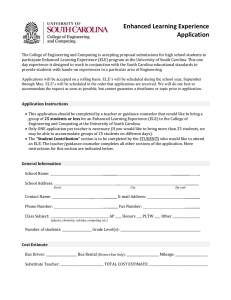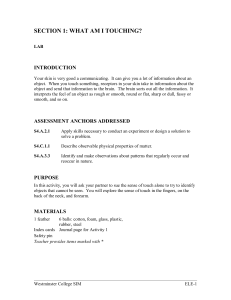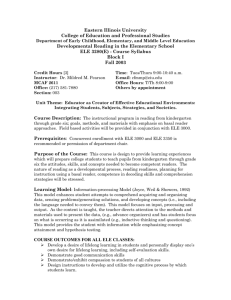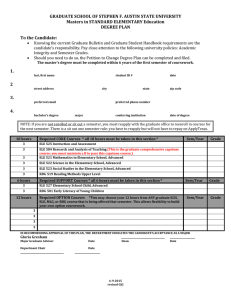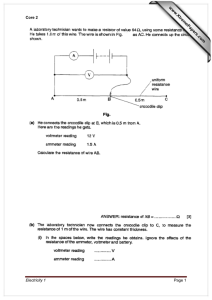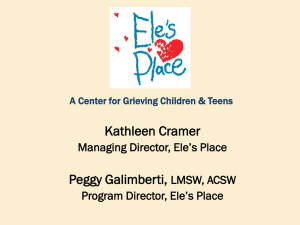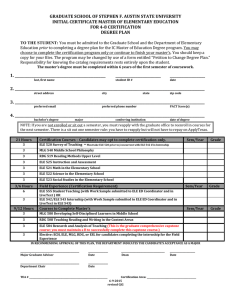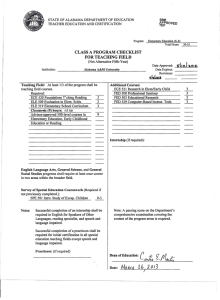Program Assessment Report (Electronic Engineering Technology) (2010)
advertisement
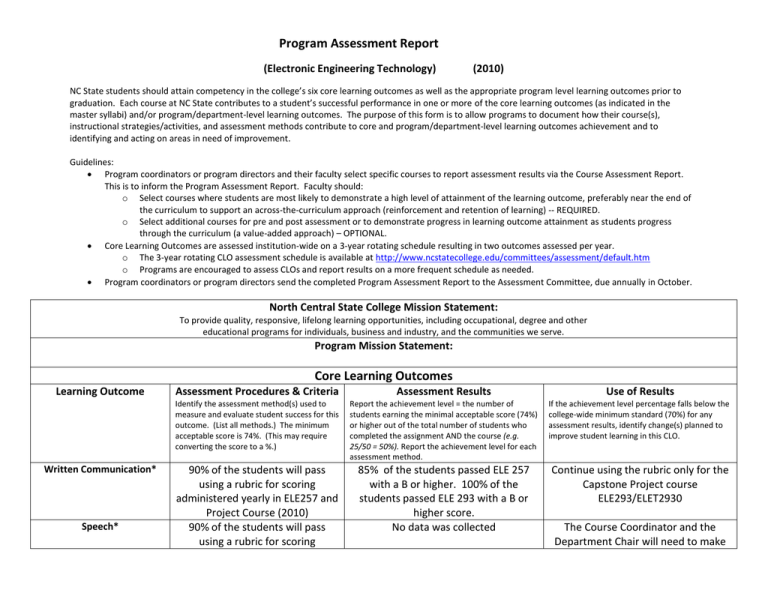
Program Assessment Report (Electronic Engineering Technology) (2010) NC State students should attain competency in the college’s six core learning outcomes as well as the appropriate program level learning outcomes prior to graduation. Each course at NC State contributes to a student’s successful performance in one or more of the core learning outcomes (as indicated in the master syllabi) and/or program/department-level learning outcomes. The purpose of this form is to allow programs to document how their course(s), instructional strategies/activities, and assessment methods contribute to core and program/department-level learning outcomes achievement and to identifying and acting on areas in need of improvement. Guidelines: Program coordinators or program directors and their faculty select specific courses to report assessment results via the Course Assessment Report. This is to inform the Program Assessment Report. Faculty should: o Select courses where students are most likely to demonstrate a high level of attainment of the learning outcome, preferably near the end of the curriculum to support an across-the-curriculum approach (reinforcement and retention of learning) -- REQUIRED. o Select additional courses for pre and post assessment or to demonstrate progress in learning outcome attainment as students progress through the curriculum (a value-added approach) – OPTIONAL. Core Learning Outcomes are assessed institution-wide on a 3-year rotating schedule resulting in two outcomes assessed per year. o The 3-year rotating CLO assessment schedule is available at http://www.ncstatecollege.edu/committees/assessment/default.htm o Programs are encouraged to assess CLOs and report results on a more frequent schedule as needed. Program coordinators or program directors send the completed Program Assessment Report to the Assessment Committee, due annually in October. North Central State College Mission Statement: To provide quality, responsive, lifelong learning opportunities, including occupational, degree and other educational programs for individuals, business and industry, and the communities we serve. Program Mission Statement: Core Learning Outcomes Learning Outcome Written Communication* Speech* Assessment Procedures & Criteria Assessment Results Use of Results Identify the assessment method(s) used to measure and evaluate student success for this outcome. (List all methods.) The minimum acceptable score is 74%. (This may require converting the score to a %.) Report the achievement level = the number of students earning the minimal acceptable score (74%) or higher out of the total number of students who completed the assignment AND the course (e.g. 25/50 = 50%). Report the achievement level for each assessment method. If the achievement level percentage falls below the college-wide minimum standard (70%) for any assessment results, identify change(s) planned to improve student learning in this CLO. 90% of the students will pass using a rubric for scoring administered yearly in ELE257 and Project Course (2010) 90% of the students will pass using a rubric for scoring 85% of the students passed ELE 257 with a B or higher. 100% of the students passed ELE 293 with a B or higher score. No data was collected Continue using the rubric only for the Capstone Project course ELE293/ELET2930 The Course Coordinator and the Department Chair will need to make administered yearly in ELE257 and Project Course (2010) Information Literacy* Critical Thinking* Intercultural Knowledge/Competence* Computation Proficiency** sure the course rubric is used and collected to obtain data. We will only be gathering data on our Capstone Project course ELE293/ELET2930. 85% of the students will pass ENR 101 "C" or better in the use of basic skills applicable to engineering. No Data Only 75% of the students passed with a “C” or higher grade. This was lower than the previous year (83%). No Data No data was collected No Data No data was collected Work on student retention and class attendance. Try for 80% success rates, We will continue this for 2011/2012. No data was collected *Rubrics are available on the Assessment of Student Learning Committee web site at http://www.ncstatecollege.edu/committees/assessment/default.htm. These rubrics may be used as is or modified, or another rubric or assessment method may be substituted. **After semester conversion, programs should report assessment results from the highest college math course in the curriculum (comprehensive final exam scores) as well assessment results that occur in non-math program courses where computation is considered to be important to the technology/profession (e.g. drug calculations in a nursing curriculum). Program-Level Learning Outcomes (add rows as needed) Learning Outcome Assessment Procedures & Criteria Assessment Results Use of Results Enter outcomes below; add rows as needed. Identify the assessment method(s) used to measure and evaluate student success for this outcome. (List all methods.) State the minimum acceptable score for each method. Report the achievement level = the number of students attaining the minimum acceptable score or higher out of the total number of students who completed the assignment AND the course (e.g. 25/50 = 50%). State the program’s minimum achievement level percentage and report the achievement level attained for each assessment method. If the achievement level percentage falls below the program’s minimum standard for any assessment results, identify change(s) planned to improve student learning in this learning outcome. 1) Demonstrate safe work habits along with care, and maintenance of equipment. 2) Develop mathematical skills in algebra, trigonometry, and calculus using analytical problem solving methods. Integrated into each engineering course. Completed OSHA Inspection in 2010 and developed Kehoe Safety Committee Will Develop an Electrical Safety test to be administered in the Electrical Motor Controls Course. Integrated into each engineering course along with test scores in MTH 121, 122, and MTH 123 Assessed in numbers 4, 5, 6, and 9. Integrated into each engineering Assessed in numbers 4, 5, 6, and 9. 3) Demonstrate principles of technical physics. 4) Demonstrate through application troubleshooting defective circuits and devices while understanding electrical and electronic devices course along with test scores in Phy 111 and PHY 112 60% of our students will successfully design, prototype, test and troubleshoot an electronic project in their capstone course ELE293/ELET2930 100 % of our students succeeded in this goal in 2010/2011 Stay the course. Understand the elements of AC and DC circuits to include voltage, current resistance, power, impedance and other relationships related to circuits. 80% of our students completing ELE 151 and ELE 152 will earn a “C” or higher grade. 84% “C” or above in ELE151 and 92% “C” or better in ELE 152. Maintain the number above 80% Apply the concepts of bipolar transistor, Field Effect Transistors and power MOSFET applications, operational amplifiers, feedback oscillators, regulated power suppliers and 555 timer. Capstone Course ELE 245. Integration of the objectives covered in ELE 150, 151, 152. 85% of our students will complete ELE 245 with a “C” or higher grade. 100% of the students completing ELE245 received a “C” or higher. Note: low enrollment caused by shifting quarter offered most likely rendered this data unreliable for 2010-2011. We also have a full-time tutoring center here at Kehoe now. Continue course curriculum. 6) Apply binary number system, Boolean algebra, LOGIC and logic circuits, flip flops, register, counters, and their interconnection in small systems. Completion of ELE 153. . 85% of our students will complete ELE 153 with a “C” or higher grade 93% of the students completed the course objectives with a "C" or better. Continue course curriculum. Completion of ELE 257 and 258. . 85% of students will complete these 2 course with a “C” or higher grade 90% of the students completed the course objectives with a "C" or better. Continue course curriculum. ELE 257 and ELE 258 will be combined into one course for semester conversion. 4) 5) 7) Demonstrate an understanding of microcontrollers to include programming language and interfacing while applying basic architecture of flow control and hardware interfacing. 8) Understand complex instruments and instrumentation systems and process control theory. Capstone Course ELE 276. Integration of ELE 153, 245, 257, 258. . 80% of students will complete the course with a “C” or higher grade. 100% of the students completed the course objectives with a "C" or better. Continue course curriculum. 9) Demonstrate practical knowledge to maintain and troubleshoot industrial control equipment through the identification of the nature and magnitude of fault or error. . 80% of students will complete ELE 224 and ELE 171 with a "C" or higher in the courses. 84% passed ELE 224 with “C” or higher grade. 94% passed ELE 171 with a “C” or higher score. Continue course curriculum. 10) Operate programmable controllers while understanding the relationship between PC's and relay ladder logic programming. . 80% of students will complete ELE 224 earning a "C" or higher. 84% passed ELE 224 with “C” or higher grade. Continue course curriculum. 11. Review AC/DC motor drives used in motion control and electronics devices and circuits. . 80% of students will complete ELE 210 with a "C" or higher in the courses. 92% of the students completed the course objectives with a "C" or better. Continue course curriculum

